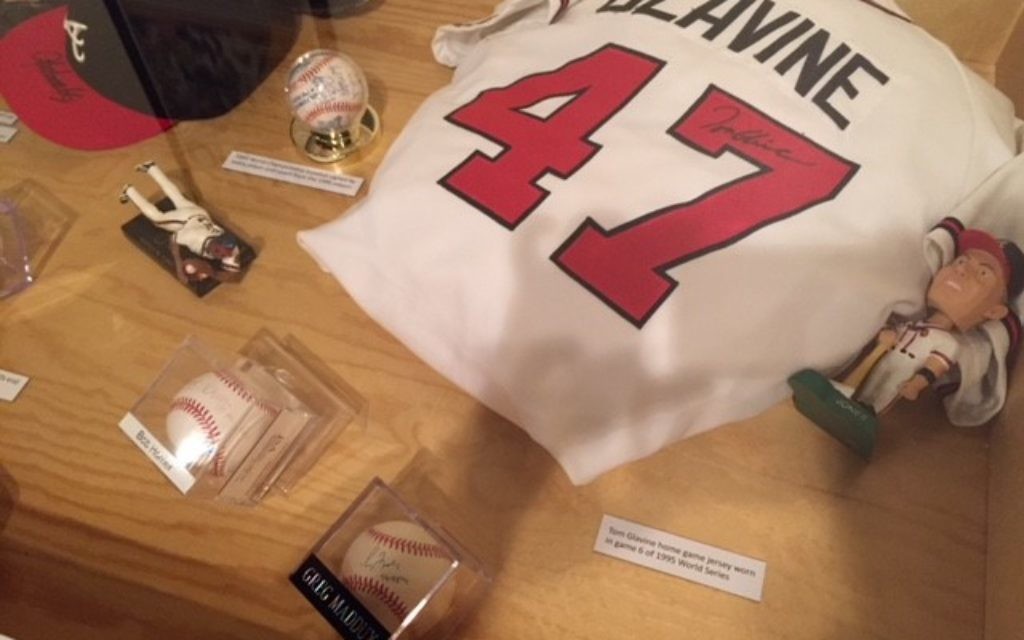Breman Takes Swing at Americanization by Baseball
Pop-up exhibit "Chasing Dreams" shows how the game and immigrants have shared the playing field.

“Let your boy play baseball and play it well. … Let us not so raise the children that they should grow up foreigners in their own birthplace.”
The above statement, from the Jewish Daily Forward in 1903, dates to a time when waves of Jewish immigrants crossed the Atlantic Ocean, uncertain what lay ahead but hopeful of a life better than what they had left behind.
Their elders may have lived with one foot in the Old World and one in the new, but the children wanted to be fully American. Baseball was an avenue to adopting that American identity.
Get The AJT Newsletter by email and never miss our top stories Free Sign Up
It was as true for the Jews as it would be for other immigrants from Europe, and for those who came from Central and South America, all seeking better lives, especially for their next generation.

And at a time when baseball was no less segregated than many other aspects of life, African-Americans sought equal treatment on the playing fields.
Quotes inscribed on large panels introduce the themes of “Chasing Dreams: Baseball & Becoming American,” an exhibit opening Sunday, May 13, at the William Breman Jewish Heritage & Holocaust Museum and running through July 15.
“To the students of most of the parochial schools, an inter-league baseball victory had come to take on only a shade less significance than a top grade in Talmud, for it was an unquestioned mark of one’s Americanism.”
— Chaim Potok, “The Chosen”
The Breman calls this a “pop-up” exhibit (not to be confused with a high fly ball), with its thematic elements drawn from a much more extensive display created by the National Museum of American Jewish History in Philadelphia.
While one monitor offers the baseball memories of men and women of various generations and ethnicities, visitors can use an interactive screen to look up Jewish major-leaguers by name, position or team.
Playing overhead, just loud enough to catch your attention — and maybe trigger memories — Atlanta Braves fans will hear calls of major moments in the team’s history (think Sid Bream’s slide, Fred McGriff’s debut home run and Bob Horner’s four round-trippers in a single game).
The Breman has supplemented the panels that outline the story with baseball memorabilia, some from the personal collection of former Atlanta Journal-Constitution sportswriter I.J. Rosenberg, now the president of sports marketing firm Score Atlanta.

There is a baseball signed by the members of the Atlanta Braves’ 1995 World Series championship team; a jersey worn by Braves pitcher Tom Glavine during Game 6 of that series, a 1-0 victory over the Cleveland Indians, Glavine’s second win of the series; a bat belonging to Dale Murphy, a Braves slugger on less successful teams the previous decade; and an autographed poster of Hank Aaron hammering his record-breaking 715th career home run April 8, 1974, at the since-demolished Atlanta-Fulton County Stadium.
Among the items lent by Rosenberg is a set of reproductions of plaques from the National Baseball Hall of Fame and Museum in Cooperstown, N.Y., autographed by the players.
Other memorabilia include a lithograph autographed by stars of the Negro Leagues.
Laurie Sedicino, the Breman’s curator, said other items will be added to the exhibit in the weeks ahead.

“Chasing Dreams” recognizes perhaps the two best-known Jewish ballplayers, Hank Greenberg and Sandy Koufax.
In the midst of a heated pennant race, Greenberg, the Detroit Tigers slugger, hit two home runs to beat the Boston Red Sox 2-1 on Rosh Hashanah in 1934, but he did not play on Yom Kippur, and the Tigers lost 5-2 to the New York Yankees.
For the next generation, Koufax, a dominating left-handed pitcher for the Los Angeles Dodgers, joined Greenberg in Jewish icon status by sitting out Game 1 of the 1965 World Series against the Minnesota Twins, which fell on Yom Kippur.
The exhibit acknowledges the history made by Georgia-born Jackie Robinson, the first African-American to play in the modern major leagues, joining the Brooklyn Dodgers in 1947; Roberto Clemente, the Puerto Rican who starred for 18 seasons with the Pittsburgh Pirates; and Justine Siegal, the first woman hired as a coach by a major-league team.

Those with a bent toward much older history may find themselves staring at large panel featuring Emanuel Lipman “Lip” Pike (born 1845, died 1893), credited as being the first Jewish professional baseball player and among the first professional baseball players.
Pike played in an era when some ballplayers changed their names to sound less Jewish.

A pair of Jewish Atlanta brothers, Marvin and Irving Goldstein, are remembered in “Chasing Dreams” for an off-the-field achievement, opening the Americana Motor Hotel, one of the first integrated hotels in the city, in 1962. The presence of the Americana helped persuade Major League Baseball to approve the move of the Braves from their former home in Milwaukee, as black and white players could stay in the same hotel.
Known today as the American, the current owner has retrofitted the hotel with midcentury design harking back more than 50 years.




comments